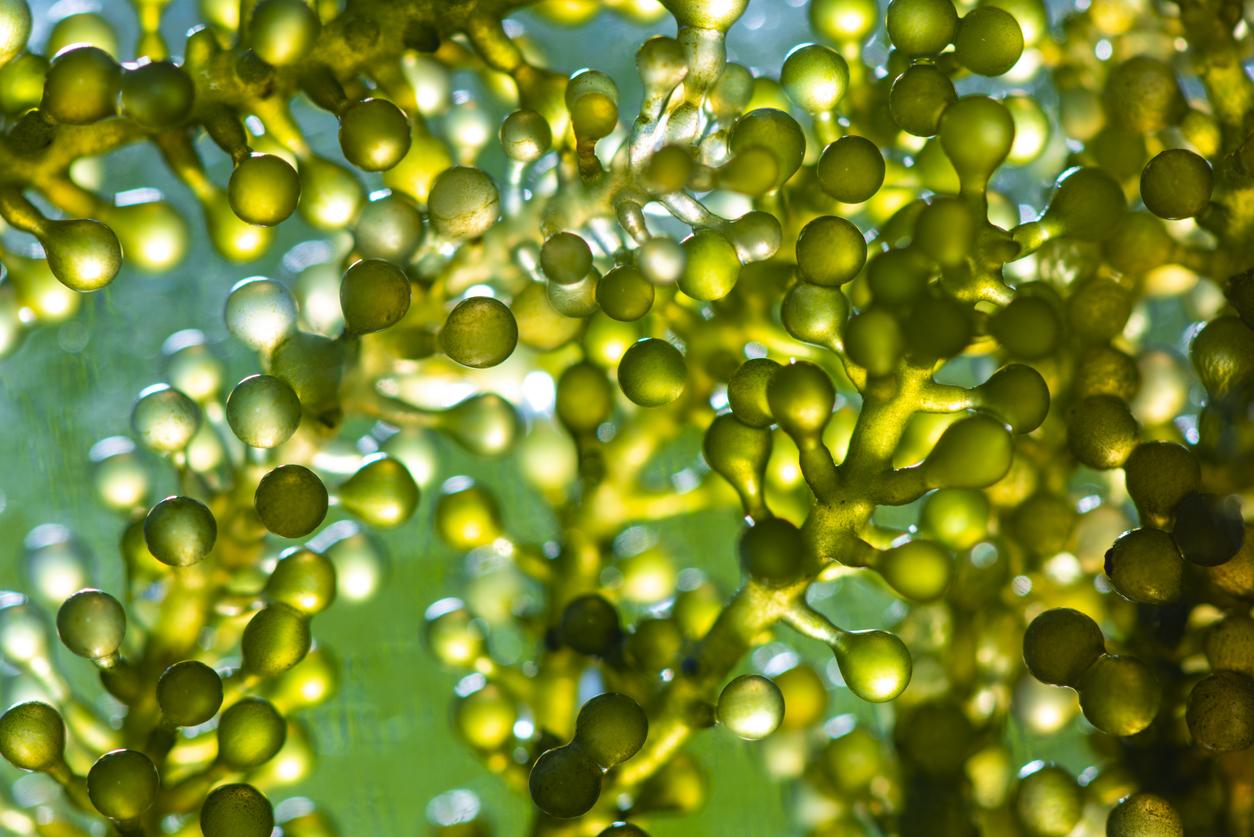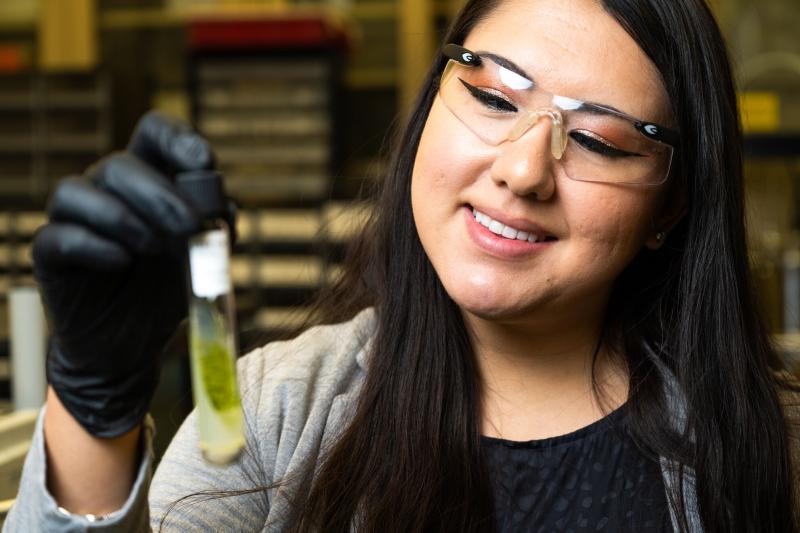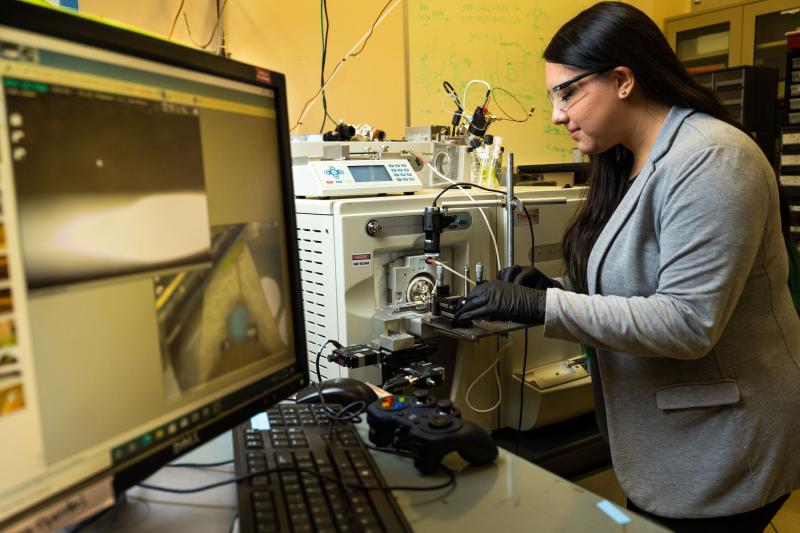Environmental Transformations and Interactions
EMSL postdoc investigates how algae affects climate, human health
Pauling Fellow Mickey Rogers looking at algae in the air

Through her research, Pauling Fellow Mickey Rogers is pairing her findings with climate models to understand how algae is affecting water sources, the atmosphere, and climate. (Photo provided by iStock)
Many people may think of algae as green slime beneath their feet as they swim in a lake or the ocean. But what happens when small bits of algae, broken up by wind and waves, are swept into the air?
Welcome to the world of Mickey Rogers.
Rogers, a 2022 Linus Pauling Distinguished Postdoctoral Fellow at the Environmental Molecular Sciences Laboratory (EMSL), has set her research sights on studying algae in the atmosphere. Specifically, she is studying how algae are released into the atmosphere, how their composition changes once airborne, and how they affect the climate and human health.
Harmful algae can cause serious health issues in people working and living along coastlines. Such health problems include respiratory distress, allergies, and skin irritation. Blue-green algae, known as cyanobacteria, even release neurotoxins such as β-Methylamino-L-alanine (BMAA) into the air. BMAA and similar toxins released are associated with Alzheimer’s and other neurodegenerative diseases—those that have the potential to degrade or even consume parts of the brain.
But not all algae are bad: 99% are considered good or offer no ill effects to humans. They are the life source for all water-based ecosystems. They also serve the planet by exhibiting excellent carbon-fixing capabilities (the highest in the world), contributing to positive advancements regarding climate change.
Rogers hopes to answer many questions on her quest to understand airborne algae, as well as their impact on the world at large. Listen to Rogers talk about her research on algae on EMSL's podcast, Bonding Over Science.

Atmospheric effects
Rogers’ fellowship research involves using mass spectrometry and electron microscopy to analyze the chemical composition and morphology of algae in the atmosphere. She plans to examine a range of airborne algae, including cultures aerosolized in a laboratory via a custom bubbling tank and field samples from the coast. These studies will help in understanding how algae affect cloud and ice formation in the atmosphere.
Even more ambitiously, Rogers wants to examine the potential for airborne algae to serve as a more efficient approach for carbon capture. She predicts that algae may capture carbon more easily in the air than in the bulk of the ocean. She also plans to work with Pacific Northwest National Laboratory’s Marine and Coastal Research Laboratory to examine toxins that become aerosolized by algae.
As a Pauling Fellow, Rogers said she is encouraged to conduct high-risk, high-reward research. Through the program, fellows investigate complicated research questions and often gain novel findings in a little-explored research area.
“EMSL is the perfect place to complete this work,” she said.
Algae are complex organisms―the kind that require powerful analytical tools to complete full characterizations. At EMSL, she has access to a variety of mass spectrometry technologies, which allow scientists to identify different chemicals and fragments in a sample by accurately identifying their mass. With this data, for instance, researchers like Rogers can paint high-resolution pictures of the physical makeup of algal-based aerosols.
“My favorite part of working at EMSL is there are all these really fun tools and toys for science,” she said. “If you have a complicated science question, like studying algae in the air, you have a surplus of tools to help with answering that question. You’re never limited in how you can do the science here.”
Algae, the future
There are many, many species of algae, Rogers said. Some estimates put the species number to over a million. And while there are harmful algae that produce toxic or harmful effects on people, animals, and ecosystems, most algae are considered beneficial.
Algae comprise the primary energy and food base for all water ecosystems. They are also used to make biofuels, as a primary ingredient in some meat substitutes, and as a feedstock for bioplastics. What makes algae so attractive in the production of bioproducts, Rogers said, is there is an abundance of them.
Algae in the atmosphere have been studied for several years, said Rogers, but most research has focused on validating their existence in the air. That leaves much more to be explored, including the impacts of algae on the climate.
"We know that when algae are blooming, they can cause water issues,” she said. “But we need to be thinking about what algae are putting in the air.”
Rogers jokes that algae could very well be the world’s future.
“But I honestly believe that,” she said. “They’re really important.”
Award-winning work
Rogers earned her PhD in 2022 at The Ohio State University and is already turning heads across the world for her early-career research on algae.
She was selected as one of 100 youth leaders worldwide to attend the Our Ocean Youth Leadership Summit in Panama City, Panama. Rogers met February 27–March 1 with other youth leaders to discuss efforts to protect and preserve the ocean. The summit concluded by kicking off the Our Ocean Conference, where she will join global leaders of all ages to discuss how youth-led efforts can offer new ocean solutions. The events are cohosted by Our Ocean Conferences and Sustainable Ocean Alliance.
Immediately after the conference, Rogers traveled to Miami, Florida, as one of 250 youth leaders to attend the Future Leaders Climate Summit, hosted by the Aspen Institute. During the first part of the conference, Rogers attended the Future Leaders Climate Summit for those ages 18–30 from March 3–6. The conference then transitioned to the Aspen Ideas: Climate Conference from March 6–9. Rogers will have the opportunity to collaborate with youth and other leaders to brainstorm new climate initiatives.
“I’m really excited,” she said. “It’s a privilege to be one of so many talented scientists, artists, policy influencers, and others at the summit who are working to protect our oceans and our climate.”

Finding answers to the tough questions
There are many complex questions regarding the future of algae—both good and bad.
In recent years, both beneficial and harmful algae research have increased due to rising temperatures, nutrient runoff to waterways, and extreme weather events like hurricanes―changes that Rogers said have had a significant impact on algae.
“By pairing the fundamental findings through my research with climate models, we aim to understand what algae are doing to our water sources, our atmosphere, and our climate,” she said.


